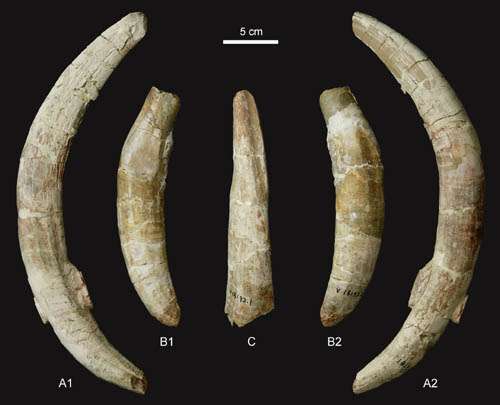Incisors of primitive rhino found from the Early Miocene of Linxia Basin in Gansu, China

Aprotodon is a large-sized primitive rhinocerotid form, distinguished by relatively robust and strongly curved lower incisors, and the specialized wide mandibular symphysis, which is similar to that of the hippopotamus. It has been reported from the Late Oligocene Jiaozigou Fauna of the Linxia Basin, but the Early Miocene deposits of this basin produced only a few lower cheek teeth. In May 2008, six huge tusk-like incisors of Aprotodon were collected from the Early Miocene Shangzhuang Formation in the Linxia Basin, and Dr. DENG Tao, Institute of Vertebrate Paleontology and Paleoanthropology (IVPP), Chinese Academy of Sciences, described them in the latest issue of Vertebrata PalAsiatica 2013(2). This find not only showed that Aprotodon survived surely into the Early Miocene in the Linxia Basin, but also proved that the climate in the Linxia Basin during the Early Miocene was similar to that of the Late Oligocene.
Although Aprotodon has an enormous size, the previously found material included only some fragmental mandibular symphyses with huge tusks from South and Central Asia, and the taxonomic position of Aprotodon was unclear. In 1997, a skull and several mandibles of Aprotodon lanzhouensis were found from the Lanzhou Basin, and the characters of Aprotodon are clearly recognized, and it was considered as an early specialized primitive true rhinoceros (family Rhinocerotidae).
The chronological and geographical distribution of Aprotodon was essentially coincident with that of giant rhinos, but the localities and numbers of individuals of Aprotodon were relatively rare. Aprotodon lanzhouensis first appeared in the Late Eocene. During the Oligocene and Early Miocene, Aprotodon apparently was rare, and it was distributed in the Lanzhou and Linxia basins as well as in Pakistan and Kazakhstan, and became totally extinct before the Middle Miocene.
As the mandibular symphysis of Aprotodon is very wide, resembling that of the hippopotamus, it may reflect an extensive aquatic environment. Accordingly, Aprotodon lived in rivers that crossed the otherwise open and dry woodland with low diversity under arid or semiarid conditions, and consequently it has a limited distribution and number of individuals.
"The extinction of Aprotodon possibly resulted from climatic changes, because the climatic and environmental characteristics during the Early Miocene were similar to those in the Late Oligocene, but different from the dense and humid forests with high diversity of the Middle Miocene", said Deng Tao.
This work was supported by the Strategic Priority Research Program of the Chinese Academy of Sciences, the Ministry of Science and Technology of China, and the National Natural Science Foundation of China.
Journal information: Vertebrata PalAsiatica




















